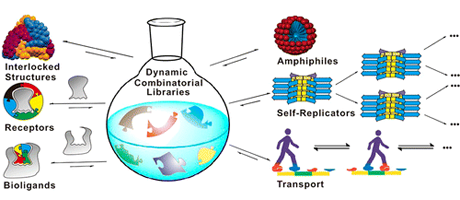Control of Dynamic Combinatorial Libraries
Traditionally the field of synthetic chemistry has focussed on performing a series of thermodynamically downhill reactions to create larger, complex molecules. In contrast, the field of Systems Chemistry takes an evolutionary approach to create complexity by creating a dynamic combinatorial library (DCL), a mixture containing a (large) number of reversibly interchanging building blocks. External or internal influences such as template molecules can drive the DCL far from equilibrium.

The Molecular Dynamics group is interested in modelling the interactions that play a role in determining the outcome of the DCL. A particular example is the reversible formation of macrocycles by dithiol-modified peptides. Initially, an equilibrium is formed between a number of different sizes of macrocycles ('species'). Once a critical macrocycle size has been reached and nucleation takes place, a single species of the library can autocatalytically self-replicate by self-assembly into nanostructures. Our aims are to predict the outcome of the DCL by creating a coarse-grain Martini model of the macrocycles that includes reversible covalent chemistry and to clarify the morphology of the nanoscale assemblies by all-atom MD.
This project is executed in collaboration with the Otto lab in the Stratingh Institute for Chemistry.
Key publications:
- E. Mattia, S. Otto, Supramolecular systems chemistry, Nat. Nanotechnol. 10, 111–119 (2015)
- M. Malakoutikhah, J.J-P. Peyralans, M. Colomb-Delsuc, H. Fanlo-Virgos, M. C. A. Stuart, S. Otto, Uncovering the Selection Criteria for the Emergence of Multi-Building-Block Replicators from Dynamic Combinatorial Libraries. J. Am. Chem. Soc., 135, 18406-18417 (2013)
